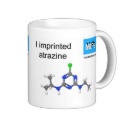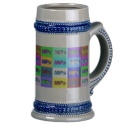|
|
Reference type: Journal
Authors: Sergeyeva TA, Brovko OO, Piletska EV, Piletsky SA, Goncharova LA, Karabanova LV, Sergeyeva LM, El'Skaya AV
Article Title: Porous molecularly imprinted polymer membranes and polymeric particles.
Publication date: 2007
Journal: Analytica Chimica Acta
Volume: 582
Issue: (2)
Page numbers: 311-319.
DOI: 10.1016/j.aca.2006.09.011
Alternative URL: http://www.sciencedirect.com/science/article/B6TF4-4KX00PW-2/2/8a775e4d71c42f8874a1b8791fcb3dda
Abstract: Porous free-standing molecularly imprinted polymer membranes were synthesised by the method of in situ polymerisation using the principle of synthesis of interpenetrating polymer networks and tested in solid-phase extraction of triazine herbicides from aqueous solutions. Atrazine-specific MIP membranes were obtained by the UV-initiated co-polymerisation of methacrylic acid, tri(ethylene glycol) dimethacrylate, and oligourethane acrylate in the presence of a template (atrazine). Addition of oligourethane acrylate provided formation of the highly cross-linked MIP in a form of a free-standing 60 μm thick flexible membrane. High water fluxes through the MIP membranes were achieved due to addition of linear polymers (polyethylene glycol Mw 20,000 and polyurethane Mw 40,000) to the initial mixture of monomers before the polymerization. As a result, typical semi-interpenetrating polymer networks (semi-IPNs) have been formed, where the cross-linked polymer was represented by the atrazine-specific molecularly imprinted polymer, while the linear one was represented by polyethylene glycol/polyurethane. Extraction of the linear polymers from the fully formed semi-IPNs resulted in formation of large pores in the membrane structure. At the same time, extraction of the template molecules lead to formation of the sites in the polymeric network, which in shape and arrangement of functional groups are complementary to atrazine. Reference polymeric membranes were prepared from the same mixture of monomers but in the absence of the template. Recognition properties of the MIP membranes were estimated in solid-phase extraction by their ability to selective re-adsorbtion of atrazine from 10-8 to 10-4 M aqueous solutions. The imprinting effect was demonstrated for both types of the MIP membranes and the influence of the type of the linear compound on their recognition properties was estimated. The recognition properties of the MIP membranes were compared to those of the MIP particles of the same composition. Morphology of the MIP membranes was investigated using the SEM microscopy. High fluxes of the developed membranes together with high affinity and adsorption capability make them an attractive alternative to MIP particles in separation processes
Template and target information: atrazine
Author keywords: Molecularly imprinted polymers, membranes, Solid-phase extraction, atrazine, triazine herbicides
|


 atrazine template mug ball and stick model
atrazine template mug ball and stick model







 multi MIPs logo beer stein
multi MIPs logo beer stein







 mips logo apron
mips logo apron






